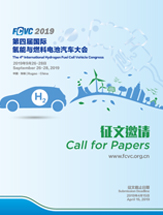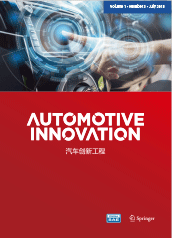

|
The journal Automotive Innovation is sponsored by China SAE, jointly published by China SAE and Springer, and reflects the top-level research and technical advance of automotive engineering. Automotive Innovation newsletter in November includes the following contents: 1. A Glimpse of Experts-Prof. Zhenhai Gao, an expert on intelligent vehicles 2. Article Recommendation-Five papers on technology of ICV, EV and Ergonomics 3. China SAE News-FCVC2019 is calling for papers on Fuel Cell Vehicle technology and the deadline is on April 15. And Implementation Plan for Eight Key Projects of "The Medium- and Long-term Development Plan of China Automotive Industry" released |

 Prof. Zhenhai Gao Dean of College of Automotive Engineering, the Vice Director of State Key Laboratory of Automotive Simulation and Control, Jilin University |
Research interests Driving Behavior Analysis, Human-Machine-Interaction, Advanced Driver Assistance System and Autopilot Technology |
||
|
Achievements Dr. Gao has more than 20 years of research experience in a broad range of automotive engineering. He took the lead in carrying out the individualized mechanism of driver manipulation behavior analysis and neuromuscular dynamics modeling. He proposed the theory, methods and key technologies of humanized design of automobile. He developed a series of human-oriented driving assistance and automatic driving algorithms. Some prototypes of ACC, AEB, LDW, FCW were developed, as well as an integral performance evaluation method and experimental testing platform were designed. The overall research level has reached the domestic leading level. Some of them have reached the international first-class level. More than 90 papers have been published in SCI and EI journals and 16 invention patents have been authorized. |
|||
|
Perspective: challenges and development trends for Smart Cars The closed-loop design theory and anthropomorphic control method of self-driving vehicle with high driving experience, chassis motion control and road adaptability are the technical challenges for the development of smart cars in the future. |

   
|
Evaluation of the Effectiveness of Awareness Messages for Road Traffic Hazards in Experimental Tests Ai Takeda,Makoto Kondo,Tetsushi Mimuro |
||
| Advanced driver assistance systems, especially autonomous emergency braking and forward collision warnings, have become popular in Japan. To reduce the number of road traffic accidents, safety information should be provided to a driver earlier than avoidance or warning messages so as to avoid a risky situation. A series of actual running tests was conducted to evaluate the activation timing and effectiveness of awareness messages. Objective analysis showed that the drivers could avoid an obstacle with a sufficient safety margin thanks to any of the awareness messages. Subjective ratings showed that the best timing is 10s before encountering the obstacle. The results of objective analysis are limited in the present paper, and further analyses are required. | |||
|
Keywords: Active safety · Advanced driver assistance systems · Awareness message · Onboard information system · Traffic hazard Takeda, A., Kondo, M., Mimuro, T.: Evaluation of the effectiveness of awareness messages for road traffic hazards in experimental tests. Automotive Innovation 1(1),76-84(2018) |
|||
| Full Paper Reading>> | |||
   
|
Simulation and Analysis on Overtaking Safety Assistance System Based on Vehicle-to-Vehicle Communication Chunmei Mo, Yinong Li, Ling Zheng |
||
| Because of the complexity and variability of an intelligent vehicle's driving environment, it is difficult for the application of the vehicular sensors to meet the needs of the surrounding environment information entirely. Vehicle-to-vehicle (V2V) communication technology is used by target vehicles to exchange information, and obtain the driving condition and driving intention of the front driver. To obtain environmental information outside the range of vehicular sensors in advance, in this paper, a vehicle overtaking assistance system is proposed based on V2V communication. The data, including the speed, position, direction angle and steering angle obtained using V2V communication, were preliminarily processed. Then, combined with an overtaking safety distance model, the vehicle parameters, driver's driving intention and vehicle status information were entered into an overtaking security assistance system to determine the overtaking conditions. Fuzzy theory was used to control the parameters of the overtaking safety distance model. Finally, the overtaking safety assistance system was established and the proposed algorithm was tested using PreScan/MATLAB cooperative simulation software. The results showed that the proposed overtaking safety algorithm effectively provided a warning according to environmental change and the driver's intention, which assisted the driver to overtake and avoid the occurrence of accidents, which improved the safety performance of the vehicle. | |||
|
Keywords: V2V communication network · Overtaking assistance · Safe distance · Active safety Mo, C., Li, Y., Zheng, L.: Simulation and analysis on overtaking safety assistance system based on vehicle-to-vehicle communication. Automotive Innovation 1(2), 158-166(2018) |
|||
| Full Paper Reading>> | |||
   
|
Driver Model-Based Fault Tolerant Control of Independent Driving Electric Vehicle Suffering Steering Failure Shaobo Lu , Sheng Cen , Yanpeng Zhang |
||
| This paper presents a fault tolerant control (FTC) strategy for a four-wheel independent driving electric vehicle suffering steering failure. The method is based on the functional redundancy of driving and braking actuators to recover the vehicle’s steering ability. A dynamic vehicle model is derived with the function of four-wheel driving. A sliding mode controller with a combined sliding surface is employed as a motion controller, allowing the desired vehicle motion to be tracked by the adaptive driver model. An extended Kalman filter-based state estimator is adopted to virtually measure the sideslip angle while considering the nonlinear tire force. A new allocation strategy, involving two distribution modes of coordination, is designed. In addition, a weight coefficient adjustment strategy is implemented in optimal mode based on the lateral load transfer, thus improving the steering performance. Simulations are conducted to verify the proposed FTC algorithm. The results demonstrate that steering failure can be effectively covered by the functional redundancy of the driving/braking actuators. | |||
|
Keywords: Fault tolerance control · Independent driving · Steering failure · Driver model · Functional redundancy Lu, S., Cen, S., Zhang, Y.: Driver model-based fault-tolerant control of independent driving electric vehicle suffering steering failure. Automotive Innovation 1(1), 85-94(2018) |
|||
| Full Paper Reading>> | |||
   
|
High-Voltage Safety Improvement Design for Electric Vehicle in Rear Impact Yubo Lian , Dong Zeng ,Sheng Ye ,Binggen Zhao, Haizhang Wei |
||
| High voltage safety is very important for electric vehicles, how to ensure the passengers’ safety in traffic accidents is an important research subject. This paper describes a study of the high-voltage safety of an electric vehicle under rear impact conditions to ensure that it is inaccordance with Chinese regulations. The high-voltage safety has been analyzed and optimized from several perspectives and includes the development of a high-voltage cutoff strategy, assessment of the integrity of the high-voltage components after the crash, the layout of the high-voltage and low-voltage cables, and the crashworthiness of the structure. This study resolved the high-voltage safety problems that were found in the design phase and thus ensured that the vehicle not only meets the requirements of the Chinese regulations, but also meets the high-voltage safety requirements of US Federal Motor Vehicle Safety Standard (FMVSS) 305 for 80 km/h rear impact. | |||
|
Keywords: Electric vehicle · Rear impact · High-voltage safety · Optimization Lian, Y., Zeng, D., Ye, S., et al.: High-voltage safety improvement design for electric vehicle in rear impact. Automotive Innovation 1(3), 211-225(2018) |
|||
| Full Paper Reading>> | |||
   
|
Investigation and Application on the Vertical Vibration Models of the Seated Human Body Xiong Shao, Nan Xu, Xiang Liu |
||
| Investigation of the vertical vibration characteristics of the seated human body is beneficial for the design and development of vehicle ride comfort. In this study, we first established models of the seated human body with two, three, and four degrees of freedom (DOF). Then, the vibration characteristics of 30 volunteers were tested under standard conditions with a vibration test rig to obtain data for the apparent mass, driving point mechanical impedance, and seat-to-head transfer function. Based on the experimental data, the parameters of these models are identified and the results show that the four-DOF model can simulate the vertical vibration characteristics of the seated human body more comprehensively. Then, different seated human body models were applied to optimize the damping of shock absorber. The results show that the optimized damping with the four-DOF Chinese seated human body model is 27% more than that with rigid mass and 7% less than that with ISO 5982:2001 seated human body model. | |||
|
Keywords: Seated human body model · Apparent mass · Driving point mechanical impedance · Seat-to-head transfer function · Optimization design of damping Shao, X., Xu, N., Liu, X.: Investigation and application on the vertical vibration models of the seated human body. Automotive Innovation 1(3), (2018) 263-271 |
|||
| Full Paper Reading>> | |||

 |
|||
| FCVC2019——Calling for papers | |||
|
FCVC2019 (the 4th International Hydrogen Fuel Cell Vehicle Congress) will be held
on September 26-28, 2019 in Rugao, China, and more than 2000 delegates will be expected to attend. FCVC 2019 is calling for papers, and all experts and scholars from the universities and research institutions around the world are welcomed to submit papers with high qualities. All accepted papers will be published in the international Journal Automotive Innovation, and some authors of best papers’ will be invited to make speeches in FCVC 2019.
Deadline: April 15, 2019 Submit paper online:http://www.fcvc.org.cn/en/ |
|||
 |
|||
| Implementation Plan for Eight Key Projects of "The Medium- and Long-term Development Plan of China Automotive Industry" released | |||
|
This study was jointly compiled by China SAE, CAAM, Tsinghua University, CATARC and CAERI. The main purpose of this study is to implement the " The Medium- and Long-term Development Plan of China Automotive Industry" issued by the Ministry of Industry and Information Technology in 2017. Eight key projects are proposed in the Medium- and Long-term Development Plan, including "Innovation Center Construction Project", "Key Parts Breakthrough Project", "Research, Development, Popularization and Application Project on New Energy Vehicle", "Promotion Project on Intelligent and Connected Vehicles", "Advanced Technology Improvement Project on Energy-Saving and Environmental-Protection Vehicle", "Vehicle+ Cross-industrial Fusion Project", "Vehicle Quality and Brand Construction Project", and "Overseas Development Project". This research listed detailed tasks for these eight projects, and some of the tasks were refined into cross-annual plans.
Research report in Chinese download for free |

|
Automotive Innovation The first top English academic journal of China’s Automotive Industry ● Global subscription ● Reflecting the top-level research and technical advance of automotive engineering ● A good platform for demonstrating the technology innovation on automobiles Editors-in-Chief Li Jun, Academician of CAE, President of China SAE, Professor of Tsinghua University Frank Zhao, President (2018-2020) of FISITA, President of Tsinghua Automotive Strategy Research Institute |
||||
|
Executive Editor-in-Chief Prof. Mike Ma,Executive Chief Editor of Automotive Innovation, Professor of Jilin University, VP Technical FISITA Paper submission and browse www.ChinaSAEJournal.com.cn www.springer.com/42154 Contacts: Ms. Huisi, Gu Tel: +86-10-50950101 Email: ghs@sae-china.org |

|
|||
|
Sponsored |
Co-operated with
|
|||